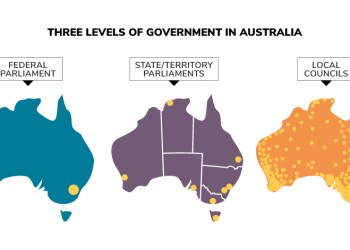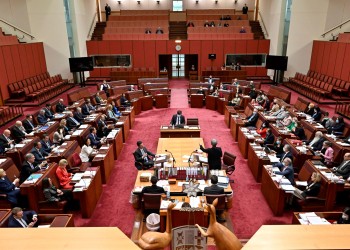Search
Format
Level
Tag
Detail
-
introducing
Introducing ... Australia's system of government
Begin your exploration of the features of Australia’s system of government with this short introduction. Discover how power is shared and managed between different groups in Australia.
-
factsheet
Australian system of government
This fact sheet examines Australia’s system of government. It includes information about representative democracy, constitutional monarchy, federation and the separation of powers.
-
System of government
Understand Australia’s democratic system of government, including the separation of powers and responsible government.
-
Rights, power, action: a practical classroom guide for teaching Australia's system of government
These classroom activities enable upper and senior secondary students to experience democratic processes first-hand, and engage with authentic legal and political issues.
-
video
Levels of government
In a land called Australia, 3 superheroes fight for the people. Discover their powers and those of the three levels of government they are named after with this video. From the ABC’s Behind the News.
-
inFocus
Three levels of government: governing Australia
In Australia the three levels of government work together to provide us with the services we need. This in-depth paper explores the roles and responsibilities of each level, how they raise money and how they work together. Case studies show how the powers of the Australian Parliament have expanded.
-
Your Parliament
This colourful and easy-to-understand booklet introduces Australia’s Parliament and explores how our system of government works. Your Parliament is aligned to the Australian Curriculum and contains engaging graphics. It is suitable for the classroom and for lifelong learners.
-
interactive
Separation of powers
Explore the separation of powers with your class with this interactive poster. Use the teaching notes and activities to support your students' learning.
-
Year 10
The PEO has a range of resources which assist teachers in their delivery of the Year 10 Australian Civics and Citizenship Curriculum.
-
PEO teacher pack
This set of PEO posters and classroom guides is what you need to explore the Australian Parliament and Australia’s system of government in your classroom.
-
factsheet
The monarch
This fact sheet explains the role of the monarch in the Australian Parliament. Find out why Australia has the King as our head of state and what power the King has in Australia.
-
Year 9
The PEO has a range of resources which assist teachers in their delivery of the Year 9 Australian Civics and Citizenship Curriculum.
-
Glossary
Use this helpful glossary to browse or search the meanings of key parliamentary terms.
-
factsheet
Australian Constitution
This fact sheet explores the Australian Constitution. It includes information about the key features of the Constitution and how it can be changed.
-
Year 10
After completing this Unit of work and associated assessment tasks, students will have met the achievement standard for the Year 10 Australian Civics and Citizenship Curriculum.
-
factsheet
Senate
This fact sheet explores the Senate, which is part of the Australian Parliament. It includes information about the role, appearance and origins of the Senate.
-
factsheet
Cabinet
Cabinet is the top decision-making group within the Australian Government. Find out more about who is in Cabinet and how it works with this fact sheet.
-
Year 6
The PEO has a range of resources which assist teachers in their delivery of the Year 6 Australian Civics and Citizenship Curriculum.
-
Prepare for your program
Getting ready to participate in a PEO program? Here are some ideas and a sensory story to help your students get the most out of their program at Parliament House.
-
Year 7
The PEO has a range of resources which assist teachers in their delivery of the Year 7 Australian Civics and Citizenship Curriculum.
-
introducing
Introducing ... Federation
Begin your exploration of Federation with this short introduction. Find out the arguments for Federation and the process that led to the creation of Australia.
-
Year 6
After completing this Unit of work and associated assessment task, students will have met the achievement standard for the Year 6 Australian Civics and Citizenship Curriculum.
-
Year 7
After completing this Unit of work and associated assessment task, students will have met the achievement standard for the Year 7 Australian Civics and Citizenship Curriculum.
-
factsheet
Rule of law
The rule of law is a key feature of Australia’s democracy and legal system. This fact sheet explains the principle of the rule of law and its relationship to the separation of powers.
-
introducing
Introducing ... the Australian Constitution
Begin your exploration of the Australian Constitution with this short introduction. Learn how the Constitution came into effect and what it takes to change it.
-
factsheet
Democracy
This fact sheet introduces the idea of democracy and explores the key ideas which support Australia’s democratic system of government.
-
factsheet
Sources of law
This fact sheet introduces the different ways law is made Australia—statute law made by parliament, delegated law made by the Executive government and common law made in courts.
-
interactive
The Australian Parliament
Introduce the Australian Parliament, its component parts and its role in your classroom with this interactive poster. Use the teaching notes and activities to support your students' learning.
-
factsheet
Rights
On this fact sheet, find out about where rights in Australia come from, types of rights and how rights are considered when Parliament makes laws.
-
factsheet
House of Representatives
This fact sheet explores the House of Representatives, which is part of the Australian Parliament. It includes information about the role, appearance and origins of the House of Representatives.
-
inFocus
Rights in Australia
This paper investigates the framework of rights in Australia. It defines the different types of rights, including human rights, and looks at the many sources for our rights and how they are protected.
-
Conduct a law reform inquiry
Investigate a law reform issue and present recommendations to a citizens’ jury.
-
interactive
Making Australian law
Understand the process of making a law in the Australian Parliament with this interactive poster. Use the teaching notes and activities to support your students' learning.
-
factsheet
Federation
In 1901, 6 British colonies united to become a new nation – the Commonwealth of Australia. This fact sheet examines the reasons for Federation, the path to Federation, the creation of the territories and the opening of the Australian Parliament.
-
Year 8
The PEO has a range of resources which assist teachers in their delivery of the Year 8 Australian Civics and Citizenship Curriculum.
-
video
Role-play the Parliament: Committee
This video demonstrates a committee role-play, where students can learn how the Australian Parliament investigates bills and issues. It outlines lesson content and what preparation is required to use this immersive learning strategy in a classroom.
-
Year 9
After completing this Unit of work and associated assessment tasks, students will have met the achievement standard for the Year 9 Australian Civics and Citizenship Curriculum.
-
inFocus
A short history of Parliament
Compared to some other parliaments around the world, Australia's Parliament is quite young but it is based on practices and ideals from much older parliaments. This in-depth paper explores the development of the Westminster system in Britain and parliamentary democracy in Australia.
-
factsheet
Parliament House
This fact sheet explores the building where the Australian Parliament meets. Discover key facts about the building and the symbolism of its design.
-
Year 5
After completing this Unit of work and associated assessment task, students will have met the achievement standard for the Year 5 Australian Civics and Citizenship Curriculum.
-
inFocus
The Federation of Australia
Australia's Federation came about through a process of deliberation, consultation and debate. This in-depth paper explores the reasons for Federation, the Federation conventions and the referendums in which the Australian people decided to join together as a nation.
-
inFocus
Australia's Parliament House
This in-depth look at Australia's Parliament House investigates why Canberra was chosen to be the nation's capital and why we needed a 'new' Parliament House. It includes the design, site and symbolism of the building.


